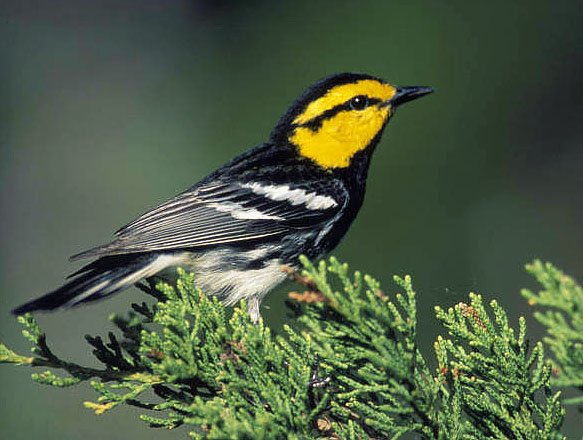| Length: 4.75 inches | Wingspan: 7.5 - 8 inches | Seasonality: Non-resident in South Dakota |
| ID Keys: Black back, head, and chest with bright yellow face and eyebrow, white underparts with dark streaks on flanks | ||
 The
Golden-cheeked Warbler is related to the more widespread
Black-throated Green Warbler
and Townsend's Warbler, two species
with relatively large ranges in eastern and western North America
(respectively). However, the Golden-cheeked Warbler is unique in that
it is the only species that breeds exclusively in Texas. There, they
are found in the oak-juniper woodlands of Central Texas, a very small
breeding range that may cover less than 350 square kilometers (IUCN
2016). They are strongly tied to the occurrence of Ashe Juniper (Juniperus
ashei) due to their preference for the use of bark from that tree as a
nesting material. Ashe Juniper trees must reach a certain age before the
bark is suitable for use in a Golden-cheeked Warbler nest, and thus the
species is dependent on suitable areas of older Ashe Juniper trees. They are
considered an endangered species in the United States. Their small
area of habitat in Texas has been even further reduced in recent decades due
to conversion of woodlands and forests to developed and agricultural uses.
The
Golden-cheeked Warbler is related to the more widespread
Black-throated Green Warbler
and Townsend's Warbler, two species
with relatively large ranges in eastern and western North America
(respectively). However, the Golden-cheeked Warbler is unique in that
it is the only species that breeds exclusively in Texas. There, they
are found in the oak-juniper woodlands of Central Texas, a very small
breeding range that may cover less than 350 square kilometers (IUCN
2016). They are strongly tied to the occurrence of Ashe Juniper (Juniperus
ashei) due to their preference for the use of bark from that tree as a
nesting material. Ashe Juniper trees must reach a certain age before the
bark is suitable for use in a Golden-cheeked Warbler nest, and thus the
species is dependent on suitable areas of older Ashe Juniper trees. They are
considered an endangered species in the United States. Their small
area of habitat in Texas has been even further reduced in recent decades due
to conversion of woodlands and forests to developed and agricultural uses.
Habitat: On their breeding grounds in Texas, Golden-cheeked Warblers are primarily found in oak-juniper woodlands, particularly in areas where Ashe Juniper is present. They are found in a variety of woodland and shrubby habitats during migration, while in winter, they are restricted to mountain pine-oak forests and woodlands.
Diet: Feeds on insects and spiders.
Behavior: Forages by gleaning insects from the surface of vegetation, either while flitting or clambering through vegetation, or by making short flights. They may also capture insects in mid-air.
Nesting: The nest of a Golden-cheeked Warbler is built by the female alone, and is placed in a small tree. She uses strips of bark from the Ashe Juniper, with spider webs to as a binding material, but will also sometimes use rootlets, grasses, small bits of vegetation, or even bits of fur that it comes across. Despite the dependence upon juniper bark for nest material, the nest itself may be placed in a variety of small trees in suitable habitat. The female lays 2-5 eggs, and she alone incubates them. The eggs hatch after about 12 days, and the young fledge from the nest about 10 days later.
Song: The song of a male Golden-cheeked Warbler is a buzzy series of phrases ending on a higher note.
Migration: Golden-cheeked Warblers are only present on their Texas breeding grounds during the summer months. They migrate through Mexico to select locations in Central America for the winter. See range map below for summer and winter range extents.
Interactive eBird map: Click here to access an interactive eBird map of Golden-cheeked Warbler sightings
Similar Species: Similar in overall appearance to Black-throated Green Warbler, Townsend's Warbler, and Hermit Warbler.
Conservation Status: Populations of Golden-cheeked Warblers have been in decline in recent decades. On both their summer breeding grounds in Texas, and on their wintering grounds in Central America, habitat loss has contributed to the decline of the species. Habitat fragmentation on their breeding grounds has increased threats from Brown-headed Cowbirds, which has also had a negative impact on the species.. The IUCN currently lists the Golden-cheeked Warbler as "Endangered".
Further Information: 1) U.S. Fish and Wildlife Service - Golden-cheeked Warbler
2) Texas Parks and Wildlife - Golden-cheeked Warbler
3) Cornell's All About Birds - Golden-cheeked Warbler
Photo Information: Photo from U.S. Fish and Wildlife Service - Licensed under Creative Commons Attribution 2.0 Generic License
| Click below for a higher-resolution map |
|
|
| South Dakota Status: Non-resident in South Dakota |
Additional Golden-cheeked Warbler Photos (coming soon!!)
